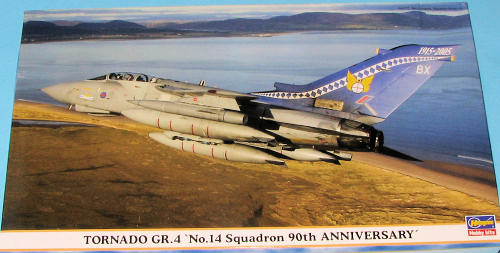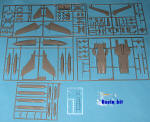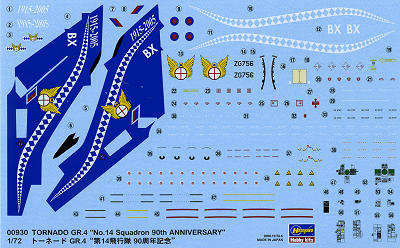
| KIT #: | ?00930 |
| PRICE: | $22.45, on sale at www.greatmodels.com |
| DECALS: | one option |
| REVIEWER: | Scott Van Aken |
| NOTES: | 2008 limited issue boxing with resin bit |

| HISTORY |
The Panavia Tornado is a family of twin-engine combat aircraft, which was jointly developed by the United Kingdom, West Germany and Italy. There are three primary versions of the Tornado; the Tornado IDS (Interdictor/Strike) fighter-bomber, the suppression of enemy air defences Tornado ECR (Electronic Combat/ Reconnaissance) and the Tornado ADV (Air Defence Variant) interceptor. The aircraft has been labelled as "for more than a quarter of a century... the most important military aircraft in Western Europe." The only overseas sales were to Saudi Arabia. Total production is just shy of 1,000 aircraft. Many Tornado units have been disbanded over the years as budget cuts and airframe hours take their toil.
As early as 1984 the UK Ministry of Defence began studies of a Mid-Life Update (MLU) of the aircraft to rectify shortcomings of the GR1. This update, to Tornado GR4 standard would improve capability in the medium level role while maintaining the Tornado's exceptional low-level penetration capability. The GR4 upgrade was not approved until 1994, after it had been revised to include lessons learned from the GR1's performance in the 1991 Gulf War. One major change was the move from low level penetration to medium level attacks, while maintaining the low level capability. The contracts were signed with British Aerospace (later BAE Systems) in 1994 for the upgrade of 142 GR1s to GR4 standard, work began in 1996 and was finished in 2003.
Upgrades to the more than twenty-year old aircraft included FLIR (Forward-Looking InfraRed), a wide-angle HUD (Heads-Up Display), improved cockpit displays, NVG (Night Vision Goggles) capabilities, new avionics and weapons systems, updated computer systems, and a Global Positioning System receiver. The updated weapons system allowed integration of the latest offensive weapons, for example the Storm Shadow and Brimstone missiles and reconnaissance equipment such as the RAPTOR pod. As of late 2006, the GR4 fleet is being fitted with a new 12.8-inch Multi-function display in the rear cockpit to replace the circular Combined Radar and Projected Map Display (CRPMD): The BAE Systems Tornado Advanced Radar Display Information System (TARDIS) is an Active-matrix liquid crystal display. TARDIS is currently being fitted to aircraft of the Fast Jet and Weapons Operational Evaluation Unit (No. 41 Squadron RAF), before being fitted to all GR4 aircraft.
| THE KIT |
 This is the old tried and true Hasegawa GR.1 kit with a small resin shard to represent the FLIR housing. Nothing else has been added in the way of cockpit instrument panel changes or additional antennas or weapons. You want the newer weapons and antennas, look to aftermarket or build your own. I'm going to bet that Hasegawa had not updated the instrument panel decals either.
This is the old tried and true Hasegawa GR.1 kit with a small resin shard to represent the FLIR housing. Nothing else has been added in the way of cockpit instrument panel changes or additional antennas or weapons. You want the newer weapons and antennas, look to aftermarket or build your own. I'm going to bet that Hasegawa had not updated the instrument panel decals either.
These kits are really quite well molded and other than having fixed slats and flaps, are ones that have met with a lot of favor in Europe. In the US, these kits seem to be major shelf-sitters as the LHS has a good half dozen of the original boxings still on the shelf. It is normal for 'swing wing' kits to have separate cockpit sections. The main fuselage is split horizontally to allow for moving wings (another reason for not having deployable flaps and slats), while the nose is spit vertically as on a standard kit. No nose weight is needed. The cockpit is fairly well detailed with adequate seat shapes, but were I to replace any part of this kit, I'd get better seats as they will be quite visible under the very clear canopy.
under the very clear canopy.
For things under wings/fuselage, you have a pair of wing tanks with Sidewinders for the inner pylon, a set of ECM pods for the outer pylons, and what looks to be a cluster bomb dispenser for the centerline. I should mention that the resin shard fits opposite the targeting window on the underside of the nose. You'll also have to open holes in the wings for the pylons and fill in the left side gun as that space is taken by the electronics for the FLIR.
All of this is clearly shown in the instructions. Usual Gunze paint references that also give BS/BSC/FS595 references where applicable. The decal sheet is well printed with white bits that are actually white. The fin markings are provided separately in case you'd rather paint that than use the decal, an option I always appreciate.
| CONCLUSIONS |
So here you have it. Another nice limited run boxing of an aircraft that I like, but am embarrassed to say have built few (the old Monogram and the Airfix kit). This seems to be the best of the lot so if your interest is in this area, you have a good one to work with.
| REFERENCES |
July 2009
You can get this kit and many other neat kits and accessories at www.greatmodels.com
If you would like your product reviewed fairly and fairly quickly, please contact the editor or see other details in the